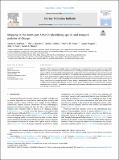Files in this item
Shipping in the north-east Atlantic : identifying spatial and temporal patterns of change
Item metadata
| dc.contributor.author | Robbins, James R. | |
| dc.contributor.author | Bouchet, Phil J. | |
| dc.contributor.author | Miller, David L. | |
| dc.contributor.author | Evans, Peter G.H. | |
| dc.contributor.author | Waggitt, James | |
| dc.contributor.author | Ford, Alex T. | |
| dc.contributor.author | Marley, Sarah A. | |
| dc.date.accessioned | 2022-05-20T11:30:15Z | |
| dc.date.available | 2022-05-20T11:30:15Z | |
| dc.date.issued | 2022-06 | |
| dc.identifier | 279577729 | |
| dc.identifier | 521bc781-11d1-4e76-b7df-09cd71508d05 | |
| dc.identifier | 85130639760 | |
| dc.identifier | 000809639500003 | |
| dc.identifier.citation | Robbins , J R , Bouchet , P J , Miller , D L , Evans , P G H , Waggitt , J , Ford , A T & Marley , S A 2022 , ' Shipping in the north-east Atlantic : identifying spatial and temporal patterns of change ' , Marine Pollution Bulletin , vol. 179 , 113681 . https://doi.org/10.1016/j.marpolbul.2022.113681 | en |
| dc.identifier.issn | 0025-326X | |
| dc.identifier.other | RIS: urn:B2AD5C168922041E83042F3970043FE4 | |
| dc.identifier.other | ORCID: /0000-0002-2144-2049/work/113061358 | |
| dc.identifier.uri | https://hdl.handle.net/10023/25426 | |
| dc.description | This work was supported by a faculty PhD bursary from the University of Portsmouth. Work was supported by the Marine Ecosystems Research Programme. | en |
| dc.description.abstract | Maritime traffic is increasing globally, with a four-fold increase in commercial vessel movements between 1992 and 2012. Vessels contribute to noise and air pollution, provide pathways for non-native species, and collide with marine wildlife. While knowledge of shipping trends and potential environmental impacts exists at both local and global levels, key information on vessel density for regional-scale management is lacking. This study presents the first in-depth spatio-temporal analysis of shipping in the north-east Atlantic region, over three years in a five-year period. Densities increased by 34%, including in 73% of Marine Protected Areas. Western Scotland and the Bay of Biscay experienced the largest increases in vessel density, predominantly from small and slow vessels. Given well-documented impacts that shipping can have on the marine environment, it is crucial that this situation continues to be monitored – particularly in areas designated to protect vulnerable species and ecosystems which may already be under pressure. | |
| dc.format.extent | 10 | |
| dc.format.extent | 2195084 | |
| dc.language.iso | eng | |
| dc.relation.ispartof | Marine Pollution Bulletin | en |
| dc.subject | Marine conservation | en |
| dc.subject | Marine protected area | en |
| dc.subject | Maritime traffic | en |
| dc.subject | Automatic identification system | en |
| dc.subject | Vessel density | en |
| dc.subject | Generalized additive model | en |
| dc.subject | GE Environmental Sciences | en |
| dc.subject | GC Oceanography | en |
| dc.subject | 3rd-DAS | en |
| dc.subject | SDG 14 - Life Below Water | en |
| dc.subject.lcc | GE | en |
| dc.subject.lcc | GC | en |
| dc.title | Shipping in the north-east Atlantic : identifying spatial and temporal patterns of change | en |
| dc.type | Journal article | en |
| dc.contributor.institution | University of St Andrews. School of Mathematics and Statistics | en |
| dc.contributor.institution | University of St Andrews. Centre for Research into Ecological & Environmental Modelling | en |
| dc.identifier.doi | https://doi.org/10.1016/j.marpolbul.2022.113681 | |
| dc.description.status | Peer reviewed | en |
This item appears in the following Collection(s)
Items in the St Andrews Research Repository are protected by copyright, with all rights reserved, unless otherwise indicated.

